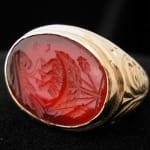Gold Ring with Classical Revival Carnelian Intaglio of a Nest, 18th Century CE
Carnelian and Gold
FJ.6971
Further images
The art of glyptics, or carving on colored precious stones, is probably one of the oldest known to humanity. Intaglios, gems with an incised design, were made as early as...
The art of glyptics, or carving on colored precious stones, is probably one of the oldest known to humanity. Intaglios, gems with an incised design, were made as early as the fourth and third millennia B.C. in Mesopotamia and the Aegean Islands. The exhibit a virtuosity of execution that suggests an old and stable tradition rooted in the earliest centuries. The tools required for carving gems were simple: a wheel with a belt-drive and a set of drills. Abrasives were necessary since the minerals used were too hard for a metal edge. A special difficulty of engraving intaglios, aside from their miniature size, was that the master had to work with a mirror-image in mind.
The Classical Revival was a phenomenon that swept through Europe in the 18th and 19th Centuries. A new appreciation for antiquity and ancient art forms was fostered by discoveries in the nascent scientific field of archaeology. Perhaps the Classical Revival also reveals a latent longing towards the Arcadian lifestyles of yesterday abandoned as Europe became rapidly industrialized and increasingly urbanized. A pastoral allegory has been engraved onto the polished surface of the carnelian gemstone. A mother bird stands upon the edge of her nest, hunched over as she prepares to feed her three young offspring who all anxiously gaze up at her with beckoning beaks. A bright star and crescent moon illuminate the sky. Perhaps this scene is symbolic of the nourishing forces of art and antiquity. This stunning ring invokes the imperial majesty of the Roman Empire while simultaneously reviving a lost art and all its beauty. Alas, the beauty of a ring such as this is as timeless as the Classics it was inspired by.
The Classical Revival was a phenomenon that swept through Europe in the 18th and 19th Centuries. A new appreciation for antiquity and ancient art forms was fostered by discoveries in the nascent scientific field of archaeology. Perhaps the Classical Revival also reveals a latent longing towards the Arcadian lifestyles of yesterday abandoned as Europe became rapidly industrialized and increasingly urbanized. A pastoral allegory has been engraved onto the polished surface of the carnelian gemstone. A mother bird stands upon the edge of her nest, hunched over as she prepares to feed her three young offspring who all anxiously gaze up at her with beckoning beaks. A bright star and crescent moon illuminate the sky. Perhaps this scene is symbolic of the nourishing forces of art and antiquity. This stunning ring invokes the imperial majesty of the Roman Empire while simultaneously reviving a lost art and all its beauty. Alas, the beauty of a ring such as this is as timeless as the Classics it was inspired by.







